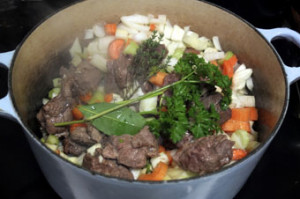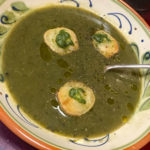
I remember my mother telling me with some incredulity that she had a friend who read cookbooks in bed, as someone might read a novel. With four children to feed at the end of a hard day’s work, cooking was a necessity for her rather than a pleasure and she cooked what she knew. Occasionally, when making jam or chutney or a cake, she would refer to an ancient notebook where she had jotted down the weights and ingredients of something outside of her daily repertoire, but reading cook books for the sake of it, was just not something she did.
I on the other hand growing up, was fascinated to learn how to cook things I had never encountered before and would cut and paste recipes that I found in newspapers and magazines into a large scrap book with the intention of one day trying them out. This vicarious cooking has continued throughout my life, and I now have a huge bookshelf groaning with recipe books from around the World.
How many of them do I actually use? It’s hard to say and that’s also not the point as there is nothing more enjoyable to me than sitting in a comfy chair and slowly turning the pages of a weighty tome and letting the descriptions and photos of mouthwatering dishes transport me to my own Neverland banquet.
Every new cookbook comes with its own degree of anticipation and excitement and when I sat down with French Regional Food by Joël Robuchon and Loïc Bienassis, I was soon engrossed. Despite what many people think, there is not a generic French cuisine, but rather a regional one, of which its individual dishes have become our idea of what French cooking is. When travelling through France, even via the motorway cafes, you quickly learn that each département you travel through has its own culinary specialities dependent on the climate and agriculture of that area. So in Normandy where diary farming predominates and there are abundant apple orchards the food is often served with buttery and creamy sauces, with the rich camembert cheese, cider and calvados (apple brandy) playing a part. In the south of France, where it is hot and dry, olive oil, tomatoes and garlic form the basis of its dishes accompanied with the hard goat and sheep cheeses and of course wine.
What French Regional Food brings to the reader, is not the haute cuisine or what is served in Michelin starred restaurants, but rather the simple local dishes, many of which have evolved over hundreds of years that make French cuisine the fascinating subject it is. The book’s 300 and some pages and 250 recipes take you on a journey across France region by region via its food and local delicacies, without you ever having to leave the confines of your own home. The book is made up of 28 chapters, each depicting a region with a brief description of its culinary history and regional specialities with a couple of recipes typical to that area.
And there were quite a few that I hadn’t come across before. For instance I learned that our neighbouring town of Beaucaire has its own special pie made with puff pastry and filled with beef kidneys, beef and beef fat with candied citrus peel, lemon and sugar traditionally served during the Easter period from Palm Sunday to fifteen days after Easter Sunday.
I decided to try two recipes, one from the Camargue, which is close to us and a dish I know well, Gardiane de Taureau, a stew made from bull beef and named after the gardiens, or cowboys from the Camargue and which is often served during the summer fêtes where we live, and another one that I have never tasted before, Poulet au Vinaigre (Chicken with vinegar) from the area around Lyon.

Both turned out very well and the chicken was particularly tender, the meat being first cooked in butter, then vinegar and served with a sauce made from the vinegar with the addition of more butter and some white wine, which emulsifies to make a creamy sauce. The only mishap with the dish was my own fault, as having taken my eye off the sauce for a moment, it split causing the butter to separate from the vinegar, but it still tasted very good and next time I make it, (and I will) I will be more vigilant.

The publishers have very kindly let me reproduce the recipe for Poulet au Vinaigre here.
Poulet au Vinaigre – Serves 4
- 1 Chicken cut into pieces
- 75g butter
- 150ml vinaigre du vin vieux (good quality red wine vinegar)
- 50ml white wine
- 1 tsp plain all-purpose flour
- salt and freshly ground pepper
Preparation and cooking
Melt 30g of the butter in a high sided frying pan set over low to medium heat. Add the chicken pieces and cook gently until they are a pale gold colour all over, (a drop of olive oil will prevent the butter from burning). Then remove the chicken from the pan and set aside. Discard the fat and any residues and wipe the pan clean and return the chicken pieces. Season with salt and pepper. Raise the heat, then add 100ml of the red wine vinegar and cover the pan immediately to avoid evaporation. Lower to a gentle heat and continue to cook the chicken for about 25 minutes or until done.
Remove the portions of chicken and transfer them to a covered dish in a warm place. Pour the rest of the vinegar together with the white wine into the pan. Over medium heat, let the liquid bubble very gently for about 4-5 minutes. Mash the remaining butter with the flour and knead to blend it, then add it to the pan and stir with a spatula until the liquid thickens unto a smooth homogenous sauce. Take it off the heat immediately. Taste and adjust the seasoning.
To serve
Transfer the pieces of chicken onto a warm serving plate and coat with the sauce and serve straight away.
Recipe taken from French Regional Food by Loic Bienassis and Joel Robuchon (Frances Lincoln, £25). Available at Amazon and QuartoKnows.com.
I would thoroughly recommend this book to any Francophile foodie, especially one who likes to travel from the comfort of their own armchair. I for one know what I will be taking to bed with me this Christmas!
Do you have a favourite French regional dish, if so, please leave a comment below. We love to hear from you.
















Hi Angela,
A great read. I won’t try these dishes (being vegetarian) but it was interesting to find out how specific to local areas French cooking is. It is wonderful how these traditions are still kept alive today.